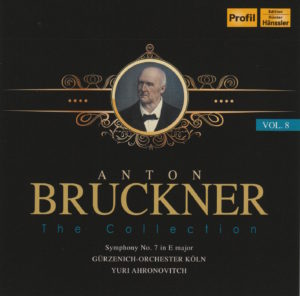 This morning’s conductor of Anton Bruckner’s Symphony No. 7 in E Major (WAB 107) is Soviet-born Israeli Yuri Ahronovitch (1932-2002). The orchestra is Gürzenich Orchestra Cologne.
This morning’s conductor of Anton Bruckner’s Symphony No. 7 in E Major (WAB 107) is Soviet-born Israeli Yuri Ahronovitch (1932-2002). The orchestra is Gürzenich Orchestra Cologne.
I’ve been listening to Bruckner’s symphonies for nearly 100 days (that’s over three months in people years), and this is the first time those names have come up.
Also, astute readers will notice that the “A” of Ahronovitch does not alphabetically follow the “C” of Chailly.
That’s because this morning’s musical selection comes from The Bruckner Collection box set, which gathers together different conductors and orchestras and offers them up for our listening pleasure.
Previously, in The Bruckner Collection, I listened to performances from:
Gerd Schaller, Day 3, Symphony No. 1
Gerd Schaller, Day 19, Symphony No. 2
Klaus Tennstedt, Day 35, Symphony No. 3
Kurt Sanderling, Day 51, Symphony No. 4
Gunter Wand, Day 67, Symphony No. 5
Bernard Haitink, Day 83, Symphony No. 6
Because I’ve never heard of Yuri Ahronovitch and Gürzenich Orchestra Cologne, I thought I’d do some poking around to learn more about them.
For example, from its entry on Wikipedia:
The Gürzenich Orchestra Cologne (Gürzenich Orchester Köln) is a German symphony orchestra based in Cologne (Köln). On some recordings, the orchestra goes under the name “Gürzenich-Orchester Kölner Philharmoniker”. Its name comes from its past principal concert venue, the Gürzenich concert hall in Cologne. Currently, its primary concert venue is the Kölner Philharmonie (Cologne Philharmonic Hall).
The Gürzenich Orchestra traces its origins to 1827, when a group of Cologne Bürger sponsored the creation of the “Cölner Concert-Gesellschaft” (Cologne Concert Society) to set up “Gesellschaftskonzerte” (Society concerts) and “Abonnementskonzerte” (subscription concerts). The orchestra began to give concerts at the Gürzenich concert hall in 1857, from which it derived its current name. In 1986, the orchestra took up residence at the Kölner Philharmonie. The orchestra also plays in opera productions in the Cologne Opera.
From his entry on Wikipedia:
Yuri Mikhaylovich Ahronovitch (13 May 1932 – 31 October 2002) was a Soviet-born Israeli conductor.
Born in Leningrad, he studied music and the violin from the age of 4. In 1954 he graduated as conductor from the Leningrad Conservatory. He studied with Nathan Rachlin and Kurt Sanderling. Invitations to conduct leading Russian orchestras followed, including the Leningrad Philharmonic and the Bolshoi Theatre.
After conducting in Petrozavodsk and Saratov, he was assigned to the Yaroslavl Philharmonic Symphony Orchestra 1956-1964, performing symphonic cycles by Beethoven and Tchaikovsky alongside Soviet music such as the works of Aram Khachaturian and Tikhon Khrennikov.
In 1964 he was appointed Chief Conductor of the USSR Ministry of Culture Symphony Orchestra and worked there until emigrating to Israel in 1972.
His recordings for Melodiya, notably Shostakovich’s First Symphony, were well received in the West.
Yuri Ahronovitch was a member of the Royal Swedish Academy of Music from 1984, and in 1987 he was decorated by the King of Sweden as “Commander of the Royal Order of the Polar Star”.
 Bruckner’s Symphony No. 7 in E Major (WAB 107), composed 1881-1883
Bruckner’s Symphony No. 7 in E Major (WAB 107), composed 1881-1883
Yuri Ahronovitch conducts
Ahronovitch used the “1885 version, ed. L. Nowak,” according to the iTunes data
Gürzenich Orchestra Cologne plays
The symphony clocks in at 67:25
This was recorded in Cologne, Germany (I think), on September 6, 1979
Ahronovitch was 47 when he conducted it
Bruckner was 59 when he finished composing it
This recording was released on the Profil label
Bruckner wrote his symphonies in four parts. The time breakdown of this one (Symphony No. 7 in E Major, version/editor unknown), from this particular conductor (Ahronovitch) and this particular orchestra (Gürzenich Orchestra Cologne) is as follows:
I. Allegro moderato…………………………………………………………………………22:51
II. Adagio. Sehr feierlich und sehr langsam…………………………………..22:11
III. Scherzo. Sehr schnell………………………………………………………………..10:02
IV. Finale. Bewegt, doch nicht schnell……………………………………………12:17
Total running time: 67:25
According to its entry on Wikipedia,
1885 version
Gutmann edition (published 1885)
Some changes were made after the 1884 premiere but before the first publication by Gutmann in 1885. It is widely accepted that Nikisch, Franz Schalk and Ferdinand Löwe had significant influence over this edition, but there is some debate over the extent to which these changes were authorized by Bruckner. These changes mostly affect tempo and orchestration.
And this, about the Nowak edition, from its entry on Wikipedia,
Nowak edition (published 1954)
Leopold Nowak kept most of the changes in the 1885 Gutmann edition, including the percussion. He reprinted the tempo modifications from Gutmann but placed them in brackets. Some performances of this edition omit the cymbal clash at the climax of the slow movement, although it is included in the printed score.
An arrangement of this symphony for chamber ensemble (consisting of 2 violins, viola, cello, bass, clarinet, horn, piano 4-hands, and harmonium) was prepared in 1921 by students and associates of Arnold Schoenberg, for the Viennese “Society for Private Musical Performances”: Hanns Eisler (1st and 3rd movements), Erwin Stein (2nd mvt.), and Karl Rankl (3rd mvt). The Society folded before the arrangement could be performed, and it was not premiered until more than 60 years later.
Of course, since the box set itself doesn’t list any of that information (I noticed it on the iTunes data from when I ripped the CD onto my laptop), I have no way of knowing if it’s accurate for this recording. It could be a mess-up in iTunes.
Okay. What do I think of this performance?
My Rating:
Recording quality: 3 (ambient sounds of shuffling, coughing, etc., plus a bit mushed together)
Overall musicianship: 4
CD liner notes: 0 (no liner notes, very little information – inexcusable for a box set!)
How does this make me feel: 4
There’s something quite grand and sweeping about this performance. The first movement was moving. The Adagio (Movement II) didn’t hit me like Barenboim’s did. This time, it was the Scherzo (Movement III) that caught my ear.
Overall, I like this performance a lot.
The quality of the recording isn’t the best I’ve heard. It sounds a bit flat or compressed. Not a lot of space between the instruments.
But this is one of the most energetic, vibrant performances I’ve heard in a awhile. It has a magical quality that leaves me feeling that I just heard something important, worthy.
Not quite a “Huzzah!”
But so close my mouth almost formed the H- sound when the Finale ended.
Of course, what this means is I’m going to have to look up more performances by Yuri Ahronovitch and Gürzenich Orchestra Cologne.
